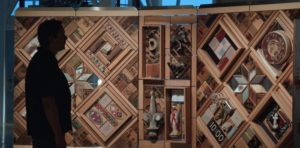Camosun College has hired a team to create a virtual reality witness blanket, inspired by traditional Indigenous woven blankets.
Second-year Camosun visual art student Louise Black, Camosun Innovates director Richard Gale, and applied research and development technologist Matt Zeleny recently went to the Canadian Museum for Human Rights in Winnipeg to spend several days scanning the blanket, which is made up of over 800 items reclaimed from residential schools, government buildings, churches, post-secondary institutions, and other places across Canada. The VR experience will allow viewers to interact with the narrative each piece provides.

Black was brought on to the project recently and is hopeful that the witness blanket will bring awareness of the tragedy of residential schools.
“Censoring information can be really problematic,” says Black, who is a member of the Tsawout First Nation. “The blanket is kind of a gentler way of addressing these issues and shedding a light on what happened with these students who went to residential schools. Some survivors have contributed artifacts that are now part of this blanket. There is a section on our website where survivors can contribute some of their stories to share, which is something that we can contribute to the VR experience as well.”
The blanket was created by University of Victoria teacher and Kwagiulth and Coast Salish artist Carey Newman.
“It’s an installation, a large-scale art piece designed to commemorate and offer respect to those who experienced residential schools in Canada,” says Gale. “It’s a very large piece, say 30 to 35 feet across, and it’s made up in the same fashion as a traditional quilt except that the resident pieces of fabric [have] images, and artifacts, text, and lots of ways of encountering the artifacts of the residential school.”
The idea was to take the idea behind a witness blanket and incorporate it into virtual reality, which is where the team came in.
Gale says that VR offers a new experience and opportunity with art, and that it also makes it accessible to everyone.
“For example, if you’re looking at a statue, we can offer a clip of the actual findings of the statue, of somebody reaching down and finding it on the roof of some building,” he says, “or listening to a survivor’s explanation of the artifact going to your audio so that you have a much richer and deeper experience of the blanket than you would have if you were just walking past it.”
Newman has been working on a way to make the witness blanket accessible to communities that would normally not be able to access it.
“When Carey agreed to make this blanket, he wanted to make it accessible to as many people as possible,” says Gale, “especially with as many survivors as possible, and to as many communities as possible. We wanted to create something that can be accessible to those who cannot travel to Winnipeg, so that through the Museum for Human Rights, they can see it through their own home setting.”
Gale believes that the VR art project will be able to help bridge the gap in reconciliation.
“The real deliverable for me is the message that reconciliation didn’t end with the Truth and Reconciliation Commission,” says Gale. “It is an ongoing process, an individual process that has to be grappled with, with every Canadian. This is something to be set apart from experience so that it will become experience—I think that is the real message that reconciliation has to offer.”
See witnessblanket.ca for more information.
